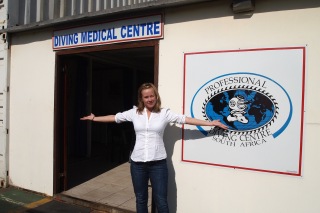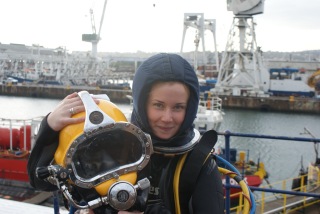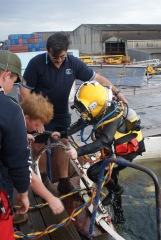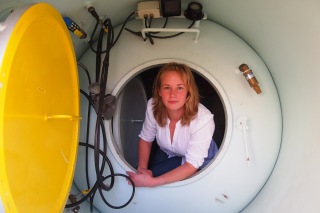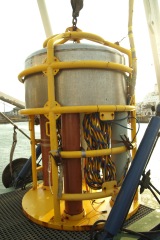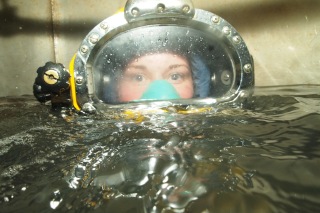This is the story about my South African medical adventure. After waiting for too many hours at the airport in Dubai, I arrived South Africa with more caffeine than blood cells in my circulation. My excitement of returning to this truly wild continent luckily overpowered my tired brain completely, and I was ready for a week back on the school bench again. Dr WAJ Meintjes and Dr Frans Cronjé at the University of Stellenbosch invited me to participate in their course ”Operational Diving Medicine” in Durban.
The course is the Module 2 in their degree for underwater medicine, and is meant for licensed physicians specializing in diving medicine. After completing the course you are an equivalent of DMAC/EDTC Level IIa physician, which enables you to work as a consultant for all diving operations, as well as performing medicals and clearing people for diving. I realized that if I had to choose only one experience during my Scholarship year which could tell me whether I wish to specialize in diving medicine or not – this was it. Since I am still just a medical student, the course would not give me any official certification, but I didn´t mind – I was there for the learning experience. Including the theory, we had practical sessions at Grant Jameson´s diving school for commercial divers, Professional Diving Centre, which gave us a taste of what to expect in the world of commercial diving (and it was awesome!)
I was lucky enough to stay with local people in Durban, which made this not only an educational adventure, but a cultural one as well. Imraan Khallil, one of Grant´s diving physicians, and his family, Tasneem and Saeera, welcomed me with open arms. Even though born and raised in South Africa, they have an Indian background – and so, they could not let me leave without tasting real Indian food. Me, having a sensitive Norwegian palate and all, started sweating from my face while eating kabaabs. Even though I can´t say I enjoy sweat forming on my cheeks during meals, it was a funny experience, and it definitely gave Imraan, Tasneem and Saeera a good laugh. It is not every day they have a sweating Norwegian at their dinner table.
The course in Operational Diving Medicine more specifically consisted of lectures from 8am-5pm, and some days also practical exposures. The lectures ranged from differential diagnoses in diving accidents and medical support for saturation diving to fitness assessment post injury or decompression illness. Heavy stuff in other words, but very practically oriented. If I could mention only one thing I learned from this course – it has to be how to handle the grey zones in diving medicine, which are more than plentiful. At Grant´s school we got our feet in the water. I got to dive in this huge tank with water, wearing a Kirby Morgan SuperLite helmet with surface supply via the umbilical. The helmet in itself weighed 14 kg, and with a normal SCUBA cylinder as bail-out, I can understand why back problems in commercial divers IS a problem. Climbing that ladder to the surface was a good work-out for me.
However, diving with a helmet instead of mask was surprisingly pleasant, and I felt like an astronaut. Just under water, which is even cooler. But I am getting ahead of myself. The day before, all the course participants did a 50 m chamber dive, and I have never ever seen so many giggling grown ups in one room.The air starts to become very dense at such a depth, and when you speak you sound exactly like Donald Duck. Now, if you add nitrogen narcosis to this squeaky cartoon-voice you are left with 5 very happy, very giggling adults. At depth, we passed around the BIBS (facemask), and took a couple of breaths of Heliox (mixture of helium and oxygen) – the effect was mindblowing. Have you seen those commercials for strong mints, chewing gum or toothpaste on TV? It was like that. It felt as if a snowstorm swept over your face and cleared your mind. Not to mention the coolness of the gas which was more than pleasant in a small chamber with 4 other sweating people. Quite an experience, and I am very grateful that Grant allowed us to try the Heliox, as it is a costly gas – and an opportunity that does not come around very often for recreational divers. Luckily, Grant also feels it is a useful experience for us who are going to treat the commercial divers, to see and understand what they are exposed to.
The course in Operational Diving Medicine was excellent, I have learned so many useful things that I will not only apply in a potential future as a diving physician, but also things I have pondered about when it comes to my everyday diving. For instance what things influence on nitrogen narcosis, and what precautions you need to take in a colder climate.
Even though the course was finished, I got the opportunity to come back the week after, which I certainly did. I joined a couple of lectures for the commercial diving students at the dive school, learning about underwater welding, what tools they use underwater, how many ways you can cut off limbs accidentally and last but not least, what divers teach diver students about treating deompression illness. It was great to see it from the diver´s point of view also, as there are many different protocols being favoured around the world. And finally, I was about to get in the water with my Kirby Morgan SuperLite again. This time it was not in a tank. I was at the bottom of Durban harbour in a wet bell. It was super-cool.
They sent me down with an experienced diver so that I wouldn´t kill myself, even though highly unlikely. The funny thing about going down in a wet bell is that you have no reference as to how deep you are whatsoever. The only way you notice that you are going deeper is the need to equalize. At the bottom I got to walk a little bit around, climb on the bell, take some photos and basically just enjoy the ride. There I was, at about 10 m depth, inside a harbour with crappy visibility – and I couldn´t help feeling like an explorer. Like an aquanaut on my way to unexplored depths not touched or spoiled by human hands.
Like Jules Verne wrote in ”Twenty Thousand Leagues Under The Sea”: ”You are going to travel through a wonderland. Astonishment and amazement will probably become your habitual state of mind… From this day on, you will be seeing what no man has yet seen..”
It is amazing what wearing a helmet can do to you.


